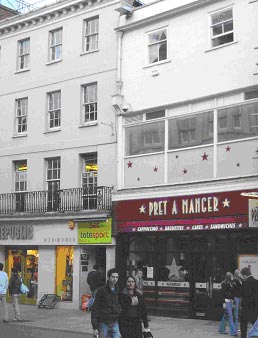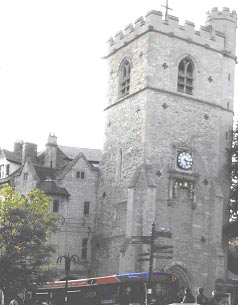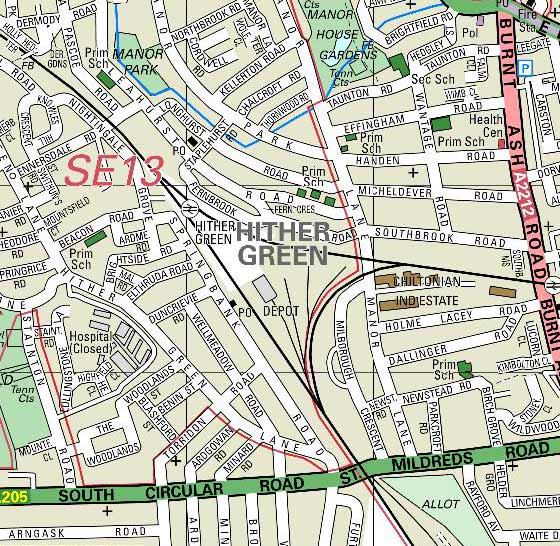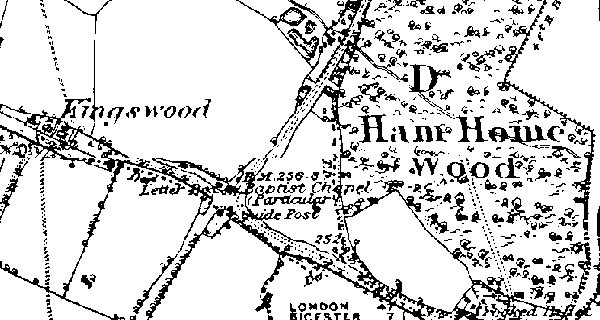
If pop-up windows should mask page views then please close them.
Oxford
George THOMPSON 1784 - 1859
2 Cornmarket Street is at the very centre of Oxford, at the meeting of the four main streets of the city, and immediately opposite the Carfax Church (St Martin’s) of which only Carfax Tower remains. A. R. Mowbray began printing and publishing at 2 Cornmarket Street in 1858 to further the aims of the Tractarian Movement; in 1880 he was apparently the first to publish religious Christmas cards. The appearance of Cornmarket Street has drastically altered by a process of demolition, rebuilding, and refronting that touched most of the buildings in the street during and since Victorian Times. This address is now occupied by Pret a Manger sandwich shop.

No. 2 Cornmarket Street

Carfax Tower – the remains of St Martin’s Church
London
George THOMPSON 1784 - 1859
In 1827 Wellington Street ran south from Strand at Exeter Change (Aldwych did not exist) to Waterloo Bridge. Wellington Street North had not been built, and Lancaster Place had not been so named. In 1841 Wellington Street North ran from 346 Strand (at the Old Bell pub) and across Tavistock Street, whilst Wellington Street ran from 130 Strand and across Lancaster Place (which started at 7 Wellington Street). In 1882 it was apparently all called Wellington Street, whilst Lancaster Place ran from 1 Wellington Street. Today Wellington Street runs from Strand at the junction with Aldwych and Lancaster Place north across Tavistock Street and into Bow Street.
Edward THOMPSON
In 1841 there were newspaper offices in Wellington Street North and Wellington Street. In 1882 No. 12 Wellington Street was occupied by the Morning Post newspaper, and there were also other newspaper offices in the street.
Percy Harrison THOMPSON
Wimbledon Park College was a private school for boys. Prior to 1929 the proprietor was Percy H Thompson. From 1929 until closure in 1939 the proprietor and Principal was Mr F. H. Lawrence, who ran the school at 139 Arthur Road SW19. During this time Mr Lawrence, Mr Wood, Mr Stanely-Goddard and a part-time Latin teacher (an Italian) taught about 36 pupils of age 6 –16 in 3 classrooms. Most of the boys stayed on until leaving age, but some left at age 11 to go on to Kings College, Wimbledon or to Rutlsih School.
Pupils included:- John Wharton (1932 – 1929), who married a girl from Wimbledon County Girls School; Philip Parry (1935 – 1939), who lived in the same street as the girl who became John Wharton’s wife. (Philip’s sister also attended Wimbledon County Girls School); and Raphael Croucher.
Mr Lawrence, a bachelor, lived in the attic of the house. He had no formal teaching qualifications, was inclined to ‘fly off the handle’ and openly expressed his dislike of the French. He had a part-time printing press and owned a very old cottage (still standing), called Shoes Farm, at Leith Hill on the North Downs. He kept beehives and sold the honey at the school, and to others. Pupils used to cycle to the farm for the day, or stay a few nights under canvas. Mr Lawrence closed the school soon after the outbreak of war, when he joined the RAF. When he was demobbed he ran his printing press as a full-time business.
Edgar Ebenezer THOMPSON

Wellmeadow Road and Springbank Road, Hither Green
Buckinghamshire
George THOMPSON b. 1833
Kingswood is a hamlet in the parish of Grendon Underwood, about 9 miles north east of Aylesbury, on Akeman Street (a Roman road that is now the A41). Akeman Street formed the eastern and southern boundary of the parish. In 1876 the parish had a population of about 450. Turnpike Road was probably Akeman Street.

Map of 1885 showing Baptist Chapel (Particular) on Akeman Street
This page was created 30 Jan 2007